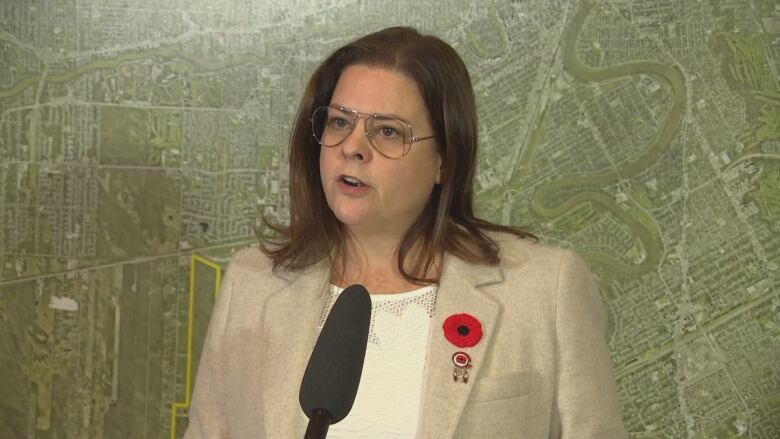Premier cites non-existent California supervised consumption sites in argument against Manitoba facilities
California does not have any sanctioned supervised consumption sites

Manitoba's premier dodged questions Thursday about why she pointed to California's experience to explain why she does not support the creation of a supervised consumption site — even though there are no sanctioned supervised consumption sites in California.
In a Wednesday interview with Information Radio host Marcy Markusa, Premier Heather Stefanson repeatedly gave California as an example of a place that saw "unintended consequences" from supervised consumption sites.
"I look at places like California that had these types of sites in place for decades, and they're not working," she said.
"It's the unintended consequences of an increase in crime around these areas — we've seen that in other jurisdictions, and I don't think we want to see that here," Stefanson said.
"In California that's exactly what happened … and that's why they reversed their decision in those areas, and they've been doing this for decades."
In fact, the first supervised consumption site in the United States was opened in New York City last November.
In August, California Gov. Gavin Newsom vetoed legislation that would have authorized a five-year consumption site pilot program in San Francisco, Oakland and Los Angeles. The proposed sites were not operational at that point.
In a veto letter, Newsom said he supports harm reduction strategies but was concerned about the lack of a strong plan for their operation.
Without referencing crime, he said "the unlimited number of safe injection sites" the proposal would allow "could induce a world of unintended consequences."

At a Thursday news conference, CBC asked the premier to clarify the remarks she made in the Wednesday interview. Stefanson said she would comment after the conference, but instead left before answering the reporter's questions.
Olivia Billson, Stefanson's press secretary, said in an emailed response "there is open drug use sites happening in California."
Open drug use is not the same as a supervised consumption site, a U.S. expert says.
"There are no official sanctioned safe injection/drug consumption centres in California," said Dessa Bergen-Cico, a professor of public health at Syracuse University in New York state who co-ordinates addiction studies programs.
Many places that provide clean syringes "have people who unofficially use their facilities to inject in the bathroom or elsewhere," but those unregulated sites "do not meet the criteria for safe injection/drug consumption sites," she said in an email.
Because such sites don't have the structured health and safety mechanisms of official drug consumption centres, Bergen-Cico said it makes sense that there may be more crime in the surrounding areas.
That crime is "not due to the injecting of drugs," she wrote, but "an indication of areas with limited public safety oversight."
Increase in crime in Alberta cited
Billson also pointed to Alberta as an example of an area where crime increased after consumption sites opened up.
A 2019 review of consumption sites in Alberta drew a link between an increase in crime and a supervised consumption site in Calgary.
But that review's methodology has been disputed, with critics saying it used distorted police data and relied heavily on public perceptions to suggest the sites contribute to an increase in crime — a finding at odds with other peer-reviewed studies.
"I think there is a very real unintended consequence to the lack of supervised consumption sites, which is the unfortunate rise in deaths that we are seeing — not just in Manitoba but in a lot of jurisdictions," said Thomas Linner, the provincial director of the Manitoba Health Coalition, which has advocated for a supervised consumption site.

In a press release Wednesday, the province said it is committed to a "recovery-oriented" model, after Mental Health and Community Wellness Minister Sarah Guillemard visited supervised consumption sites in Vancouver.
On Thursday, a spokesperson for Guillemard said the "recovery-oriented" approach "includes evidence-based supports through prevention, early intervention, treatment and recovery, and a continuous pursuit of recovery."
The Progressive Conservative government's priority is "to maximize investments in programs and services," such as the province's rapid access to addictions medicine, or RAAM, clinics, "which we know work for individuals on their recovery journeys," the spokesperson said in an email.
The province's Wednesday release referenced a walk through Vancouver's East Hastings neighbourhood — home to Insite, North America's longest-running supervised consumption site — where Guillemard said she witnessed people using drugs on sidewalks in front of the facility.
She noted concerns "with unregulated supervised consumption sites and serious consequences to individuals and communities," the release said.
![I smiling woman wears a T-shirt with the slogan, "I [heart-shaped symbol] someone who uses drugs."](https://i.cbc.ca/1.6648425.1668130827!/fileImage/httpImage/image.jpeg_gen/derivatives/original_780/shohan-illsley.jpeg)
Manitoba Harm Reduction Network executive director Shohan Illsley said those observations can be found in Winnipeg as well, and a safe site here would actually provide drug users an alternative place to go.
"The reality is we have people who are using substances outside already. We have people who are using substances in bus shacks … [and] in Tim Hortons bathrooms," Illsley said.
Compared to what the minister saw in Vancouver, "what would happen here in Manitoba would look a little different," she said.
"At the end of the day, our goal is to reduce the number of people who are dying of drug poisoning."
B.C. drug overdoses rising, but not at supervised site
The province's Wednesday release also said cities that have supervised consumption sites are not seeing reductions in drug use or overdose deaths.
This week, the B.C. Coroners Service released its monthly report on overdose deaths, which said at least 171 people there died from toxic drugs in September.
At least 1,644 people in B.C. have died from overdoses so far this year — putting the province on track to surpass 2,000 annual deaths for the second year in a row.
According to PHS Community Services Society, which runs Insite, there have not been any overdose deaths at the facility since it opened in 2003.

The Manitoba Health Coalition's Linner said it's unfair to assume that injection sites aren't making a difference.
"I think the real question to ask is how many more people would have died without those supervised consumption sites. And I think the answer to that is pretty obvious that it would be a heck of a lot more."
The sites "are not the be all and end all of harm reduction," but "they are a necessary component that gets people from today to tomorrow, and the opportunity for better choices," said Linner.
"I think that's what the premier is desperately missing in this conversation."

